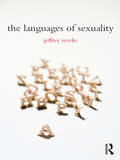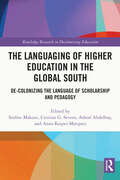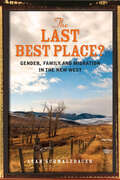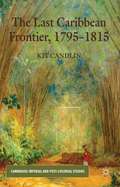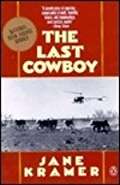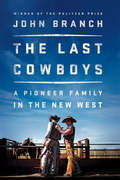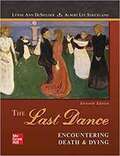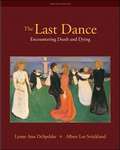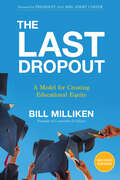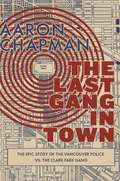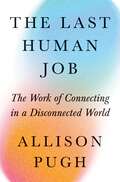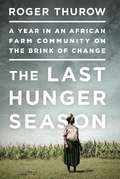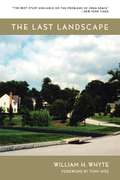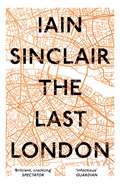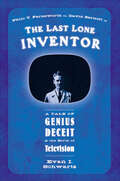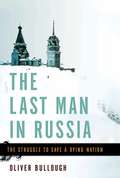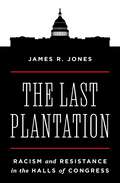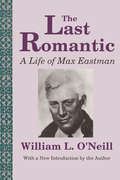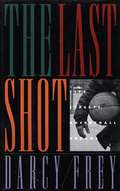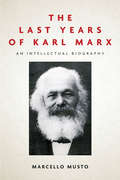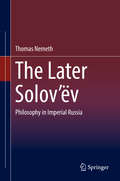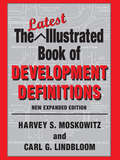- Table View
- List View
The Languages of Sexuality
by Jeffrey WeeksWords, Freud once wrote, are magic. Nowhere have words been more magical than in the writing of sexuality. Through words and concepts we learn what is good or bad, pleasurable or painful, significant and insignificant. The terms we use about sexuality do not simply describe something out there. They help shape what sexuality is. The Languages of Sexuality offers concise and incisive essays on key words and concepts which have played a significant role in shaping our understanding of contemporary sexualities and intimacies. Nearly a hundred essays illuminate the terms related to sexuality in fresh, and often unexpected ways, with entries ranging from ‘abjection’ and ‘abortion’ to ‘transgender and ‘Viagra’. Written with clarity, insight and passion by an internationally renowned theorist of sexuality, this book is not only an invaluable handbook, but also a personal exploration of the fluid, shifting, ever evolving meanings of sexual life as reflected and refracted through words and concepts. This book is an invaluable resource for both students and researchers with interests relating to sexuality and intimate life, gender studies, cultural studies, history and sociology. It will also appeal to a wider audience interested in critical debates about the nature and meanings of contemporary sexualities.
The Languages of the Jews
by Bernard SpolskyHistorical sociolinguistics is a comparatively new area of research, investigating difficult questions about language varieties and choices in speech and writing. Jewish historical sociolinguistics is rich in unanswered questions: when does a language become 'Jewish'? What was the origin of Yiddish? How much Hebrew did the average Jew know over the centuries? How was Hebrew re-established as a vernacular and a dominant language? This book explores these and other questions, and shows the extent of scholarly disagreement over the answers. It shows the value of adding a sociolinguistic perspective to issues commonly ignored in standard histories. A vivid commentary on Jewish survival and Jewish speech communities that will be enjoyed by the general reader, and is essential reading for students and researchers interested in the study of Middle Eastern languages, Jewish studies, and sociolinguistics.
The Languaging of Higher Education in the Global South: De-Colonizing the Language of Scholarship and Pedagogy (Routledge Research in Decolonizing Education)
by Sinfree Makoni Anna Kaiper-Marquez Cristine G. Severo Ashraf AbdelhayBy foregrounding language practices in educational settings, this timely volume offers a postcolonial critique of the languaging of higher education and considers how Southern Epistemologies can be used to further the decolonization of post-secondary education in the Global South. Offering a range of contributions from diverse and minoritized scholars based in countries including South Africa, Rwanda, Sudan, Qatar, Turkey, Portugal, Sweden, India and Brazil, The Languaging of Higher Education in the Global South problematizes the use of language in various areas of higher education. Chapters demonstrate both subtle and explicit ways in which the language of pedagogy, scholarship, policy, and partcipiation endorse and privelege Western constructs and knowledge production, and utilize Southern theories and epistemologies to offer an alternative ways forward – practice and research which applies and promotes Southern epistemologies and local knowledges. The volume confronts issues including integrationism, epistemic solidarity, language policy and ideology, multilingualism, and the increasing use of technology in institutions of higher education. This innovative book will be of interest to researchers, scholars, and postgraduate students in the fields of higher education, applied linguistics, and multicultural education. Those with an interest in the decolonization of education and language will find the book of particular use.
The Last Best Place? Gender, Family, and Migration in the New West
by Leah SchmalzbauerSouthwest Montana is beautiful country, evoking mythologies of freedom and escape long associated with the West. Partly because of its burgeoning presence in popular culture, film, and literature, including William Kittredge's anthology The Last Best Place, the scarcely populated region has witnessed an influx of wealthy, white migrants over the last few decades. But another, largely invisible and unstudied type of migration is also present. Though Mexican migrants have worked on Montana's ranches and farms since the 1920s, increasing numbers of migrant families—both documented and undocumented—are moving to the area to support its growing construction and service sectors. The Last Best Place? asks us to consider the multiple racial and class-related barriers that Mexican migrants must negotiate in the unique context of Montana's rural gentrification. These daily life struggles and inter-group power dynamics are deftly examined through extensive interviews and ethnography, as are the ways gender structures inequalities within migrant families and communities. But Leah Schmalzbauer's research extends even farther to highlight the power of place and demonstrate how Montana's geography and rurality intersect with race, class, gender, family, illegality, and transnationalism to affect migrants' well-being and aspirations. Though the New West is just one among many new destinations, it forces us to recognize that the geographic subjectivities and intricacies of these destinations must be taken into account to understand the full complexity of migrant life.
The Last Caribbean Frontier, 1795�1815
by Kit CandlinThe Southern Caribbean was the last frontier in the Atlantic world and the most contested region in the Caribbean during the Age of Revolution. As well as illuminating this little-understood region, the book seeks to complicate our understanding of the Caribbean, the role of 'free people of colour' and the nature of slavery.
The Last Cowboy
by Jane KramerPortrays the life of a man who strives to be "a proper cowboy" despite radical changes which have propelled the Old West into a New Southwest characterized by industrialized agribusiness.<P><P> 'The West that Henry mourned belonged to the Western movie, where the land and the cattle went to their proper guardians and brought a fortune in respect and power. It was a West where the best cowboy got to shoot the meanest outlaw, woo the prettiest schoolteacher, bed her briefly to produce sons, and then ignore her for the finer company of other cowboys - a West as sentimental and as brutal as the people who made a virtue of that curious combination of qualities and called it the American experience.' From the Introduction: Henry Blanton is the 'last cowboy' of Jane Kramer's classic portrait, the failed hero of his own mythology, the man who ends an era for himself. His story - his flawed, funny, and in the end tragic efforts to be a proper cowboy, 'expressin' right' in a world where the range is a feed yard and college boys run ranches from air-conditioned Buicks -is the story of a country coming of age in great promise and greater disappointment. A hundred and fifty miles up the highway from agri-business Amarillo, Henry claimed the extravagant prerogatives of a free man on a horse. He rode his own frontier, decked out in his vigilance and his honour, until the shocking moment when in the person of Henry Blanton the West and the Western had a showdown.<P> Winner of the National Book Award
The Last Cowboys: A Pioneer Family In The New West
by John BranchA gripping portrait of one family’s gamble that rodeo and ranching are the future of the West—and not just its past. For generations, the Wrights of southern Utah have raised cattle and world-champion saddle-bronc riders—some call them the most successful rodeo family in history. Now Bill and Evelyn Wright, parents to 13 children and grandparents to many more, find themselves struggling to hang on to the majestic landscape where they’ve been running cattle for 150 years as the West is transformed by urbanization, battered by drought, and rearranged by public-land disputes. Could rodeo, of all things, be the answer? In a powerful follow-up to his prize-winning, best-selling first book, New York Times reporter John Branch delivers an epic and intimate family story deep in the American grain. Written with great lyricism and filled with vivid scenes of ranch life and the high drama of saddle-bronc competition, The Last Cowboys chronicles three years in the life of the Wrights, each culminating in rodeo’s National Finals in Las Vegas. Will Bill and Evelyn be able to hold the family together as rodeo injuries pile up and one of their sons goes off on a religious mission? Will their son Cody, a two-time world champion, make it to the finals one last time—and compete with his own son? And will the younger generation—Rusty, Ryder, Stetson, and the rest—be able to continue the family’s ways in the future? This is a grand and compelling work of reporting that, like Buzz Bissinger’s Friday Night Lights, offers deep insight into American ritual and tradition. And in telling the Wright family’s story, from branding days to rodeo nights to annual Christmas gatherings, Branch captures something vital of the grit, determination, and integrity that fuel the American Dream. An unforgettable book by one of the finest reporters of our time, The Last Cowboys is a moving tribute to an American way of life.
The Last Dance: Encountering Death and Dying
by Albert Lee Strickland Lynne Ann DeSpelder Jeanette M. Potts Marion MasonThe Last Dance: Encountering Death and Dying provides a comprehensive, up to date, and readable introduction to the study of death and dying. It directs attention to the evolving understanding of death and dying in today's culturally diverse environment. In a straightforward, conversational style, with an extensively illustrated format, The Last Dance provides a solid grounding in theory and research as well as in methods for applying what is learned to readers' own circumstances, both personal and professional. No other textbook so successfully combines the research and theories of such diverse disciplines as anthropology, art, ethics, health science, literature, philosophy, psychology, public policy, religion, and sociology. The eleventh edition of The Last Dance includes coverage of key topics yet retains the focus, writing, and pedagogy instructors have come to expect from the best-selling text in death studies.
The Last Dance: Encountering Death and Dying (Ninth Edition)
by Albert Lee Strickland Lynne Ann DespelderThe best-selling textbook in its field, The Last Dance offers an interdisciplinary approach to the study of death and dying. Integrating the experiential, scholarly, social, individual, emotional, and intellectual dimensions of death and dying, this acclaimed text provides solid grounding in theory and research, as well as practical application to students' lives. The ninth edition has been updated to offer cutting-edge and comprehensive coverage of death studies.
The Last Dropout: A Model for Creating Educational Equity
by Bill MillikenA revised and updated edition of an exploration into the foundational principles, impact, and real-life success stories from Communities In Schools.Since 1977, Communities In Schools (CIS) has reached more than one million students and their families annually approximately 3,000 American schools, surrounding them with a community of support and empowering them to stay in school and achieve in life.In The Last Dropout, CIS founder Bill Milliken offers nine key principles that Communities In Schools has tested over four decades. Interwoven are his real-world life stories, a journey that began in the turbulent 1960s as a youth worker and evolved into a handful of groundbreaking "Street Academies" that became the CIS movement with a national network of hundreds of local affiliates. Milliken also shares transformative stories about how CIS leaders have adopted these principles in their own communities, with stunning results.Milliken's guiding philosophy has been "It is relationships, not programs, that change children," and it is a principle that has served as a beacon in the movement for educational equity and success.
The Last Gang in Town
by Aaron ChapmanDecades before organized crime syndicates brought sensational drug wars to Vancouver, street gangs held sway over its unruly east side. None was considered tougher or more feared than the Clark Park gang, a wild, two-fisted crew of characters from Vancouver's post-1960s counterculture. In 1972, after a number of headline-making riots and clashes with police―including an infamous altercation outside a Rolling Stones concert―the Clark Parkers became the target of a secret undercover police squad. Their hostile interactions culminated in a notorious police shooting, resulting in the death of a Clark Park gang member. Combining meticulous research with a keen flair for storytelling, The Last Gang in Town features previously unpublished photos and police documents, as well as testimonials by surviving gang members and police officers who speak for the first time on the subject. The book is a compelling portrait of early-1970s Vancouver and an intriguing and sensational history that puts the spotlight on the after-dark underbelly of the city's not-so-distant criminal past.
The Last Great War
by Adrian GregoryWhat was it that the British people believed they were fighting for in 1914–18? This compelling history of the British home front during the First World War offers an entirely new account of how British society understood and endured the war. Drawing on official archives, memoirs, diaries and letters, Adrian Gregory sheds new light on the public reaction to the war, examining the role of propaganda and rumour in fostering patriotism and hatred of the enemy. He shows the importance of the ethic of volunteerism and the rhetoric of sacrifice in debates over where the burdens of war should fall as well as the influence of religious ideas on wartime culture. As the war drew to a climax and tensions about the distribution of sacrifices threatened to tear society apart, he shows how victory and the processes of commemoration helped create a fiction of a society united in grief.
The Last Human Job: The Work of Connecting in a Disconnected World
by Allison J. PughA timely and urgent argument for preserving the work that connects us in the age of automationWith the rapid development of artificial intelligence and labor-saving technologies like self-checkouts and automated factories, the future of work has never been more uncertain, and even jobs requiring high levels of human interaction are no longer safe. The Last Human Job explores the human connections that underlie our work, arguing that what people do for each other in these settings is valuable and worth preserving.Drawing on in-depth interviews and observations with people in a broad range of professions—from physicians, teachers, and coaches to chaplains, therapists, caregivers, and hairdressers—Allison Pugh develops the concept of &“connective labor,&” a kind of work that relies on empathy, the spontaneity of human contact, and a mutual recognition of each other&’s humanity. The threats to connective labor are not only those posed by advances in AI or apps; Pugh demonstrates how profit-driven campaigns imposing industrial logic shrink the time for workers to connect, enforce new priorities of data and metrics, and introduce standardized practices that hinder our ability to truly see each other. She concludes with profiles of organizations where connective labor thrives, offering practical steps for building a social architecture that works.Vividly illustrating how connective labor enriches the lives of individuals and binds our communities together, The Last Human Job is a compelling argument for us to recognize, value, and protect humane work in an increasingly automated and disconnected world.
The Last Hunger Season
by Roger ThurowAt 4:00 am, Leonida Wanyama lit a lantern in her house made of sticks and mud. She was up long before the sun to begin her farm work, as usual. But this would be no ordinary day, this second Friday of the new year. This was the day Leonida and a group of smallholder farmers in western Kenya would begin their exodus, as she said, “from misery to Canaan,” the land of milk and honey. Africa’s smallholder farmers, most of whom are women, know misery. They toil in a time warp, living and working essentially as their forebears did a century ago. With tired seeds, meager soil nutrition, primitive storage facilities, wretched roads, and no capital or credit, they harvest less than one-quarter the yields of Western farmers. The romantic ideal of African farmers––rural villagers in touch with nature, tending bucolic fields––is in reality a horror scene of malnourished children, backbreaking manual work, and profound hopelessness. Growing food is their driving preoccupation, and still they don’t have enough to feed their families throughout the year. Thewanjala––the annual hunger season that can stretch from one month to as many as eight or nine––abides. But in January 2011, Leonida and her neighbors came together and took the enormous risk of trying to change their lives. Award-winning author and world hunger activist Roger Thurow spent a year with four of them––Leonida Wanyama, Rasoa Wasike, Francis Mamati, and Zipporah Biketi––to intimately chronicle their efforts. InThe Last Hunger Season,he illuminates the profound challenges these farmers and their families face, and follows them through the seasons to see whether, with a little bit of help from a new social enterprise organization called One Acre Fund, they might transcend lives of dire poverty and hunger. The daily dramas of the farmers’ lives unfold against the backdrop of a looming global challenge: to feed a growing population, world food production must nearly double by 2050. If these farmers succeed, so might we all.
The Last Landscape
by William H. Whyte Tony HissThe remaining corner of an old farm, unclaimed by developers. The brook squeezed between housing plans. Abandoned railroad lines. The stand of woods along an expanded highway. These are the outposts of what was once a larger pattern of forests and farms, the "last landscape." According to William H. Whyte, the place to work out the problems of our metropolitan areas is within those areas, not outside them. The age of unchecked expansion without consequence is over, but where there is waste and neglect there is opportunity. Our cities and suburbs are not jammed; they just look that way. There are in fact plenty of ways to use this existing space to the benefit of the community, and The Last Landscape provides a practical and timeless framework for making informed decisions about its use. Called "the best study available on the problems of open space" by the New York Times when it first appeared in 1968, The Last Landscape introduced many cornerstone ideas for land conservation, urging all of us to make better use of the land that has survived amid suburban sprawl. Whyte's pioneering work on easements led to the passage of major open space statutes in many states, and his argument for using and linking green spaces, however small the areas may be, is a recommendation that has more currency today than ever before.
The Last London: True Fictions from an Unreal City
by Iain SinclairA New Statesman Book of the Year London. A city apart. Inimitable. Or so it once seemed. Spiralling from the outer limits of the Overground to the pinnacle of the Shard, Iain Sinclair encounters a metropolis stretched beyond recognition. The vestiges of secret tunnels, the ghosts of saints and lost poets lie buried by developments, the cycling revolution and Brexit. An electrifying final odyssey, The Last London is an unforgettable vision of the Big Smoke before it disappears into the air of memory.
The Last Lone Inventor: A Tale of Genius, Deceit, and the Birth of Television
by Evan I. Schwartz“…Fascinating… A riveting American classic of independent brilliance versus corporate arrogance. I found it more fun than fiction.” — James Bradley, author of Flags of Our Fathers“… The fascinating inside story of how this eccentric loner invented television and fought corporate America.” — Walter Isaacson, chariman, CNN“…Compelling…Strong, dramatic prose…” — Kirkus Reviews“…A lively and engaging account.” — Library Journal“[A] gripping and eminently readable saga of the birth of television and the death of the Edisonian myth.” — Darwin magazine
The Last Man in Russia: The Struggle to Save a Dying Nation
by Oliver BulloughRussia is dying from within. Oligarchs and oil barons may still dominate international news coverage, but their prosperity masks a deep-rooted demographic tragedy. Faced with staggering population decline--and near-certain economic collapse--driven by toxic levels of alcohol abuse, Russia is also battling a deeper sickness: a spiritual one, born out of the country’s long totalitarian experiment. In The Last Man in Russia, award-winning journalist Oliver Bullough uses the tale of a lone priest to give life to this national crisis. Father Dmitry Dudko, a dissident Orthodox Christian, was thrown into a Stalinist labor camp for writing poetry. Undaunted, on his release in the mid-1950s he began to preach to congregations across Russia with little concern for his own safety. At a time when the Soviet government denied its subjects the prospect of advancement, and turned friend against friend and brother against brother, Dudko urged his followers to cling to hope. He maintained a circle of sacred trust at the heart of one of history’s most deceitful systems. But as Bullough reveals, this courageous group of believers was eventually shattered by a terrible act of betrayal--one that exposes the full extent of the Communist tragedy. Still, Dudko’s dream endures. Although most Russians have forgotten the man himself, the embers of hope that survived the darkness are once more beginning to burn. Leading readers from a churchyard in Moscow to the snow-blanketed ghost towns of rural Russia, and from the forgotten graves of Stalin’s victims to a rock festival in an old gulag camp, The Last Man in Russia is at once a travelogue, a sociological study, a biography, and a cri de coeur for a dying nation--one that, Bullough shows, might yet be saved.
The Last Mile: Turning Public Policy Upside Down (Innovations, Practice and the Future of Public Policy in India)
by Amarjeet SinhaThe Last Mile explores the gaps and dichotomy between drafted policies and their implementation, and the last mile challenges which often make public services inaccessible to the poorest and most vulnerable sections of society. It provides an in-depth overview of the dynamics between communities, research and consultation and the implementation of policies for development. Rich in empirical data and case studies from different government programmes and reports, this book examines the implementation of government service programmes for poverty reduction, women’s empowerment, and income generation for the poor, among others, from a people’s perspective. It highlights the need for policies and institutions to align their methods to community needs. Offering guidelines for redesigning as well as solutions to counter challenges related to lack of trust and effective communication, human resource management, capacity development, redressal mechanisms, and facilitating the last mile connection, the author delineates effective ways for integrating new technologies in policy implementation. The book also addresses legacy issues in institutions and re-orienting policy for better governance, transparency, and building trust. Part of the Innovations, Practice and the Future of Public Policy in India series, this book, by a senior practitioner, will be an essential resource for students and researchers of development studies, sociology, public policy and governance, economics, and South Asian studies. This book is freely available as a downloadable Open Access PDF at http://www.taylorfrancis.com under a Creative Commons (CC-BY-NC-ND) 4.0 license.
The Last Plantation: Racism and Resistance in the Halls of Congress
by James R. JonesA revealing look at the covert and institutionalized racism lurking in the congressional workplaceRacism continues to infuse Congress&’s daily practice of lawmaking and shape who obtains congressional employment. In this timely and provocative book, James Jones reveals how and why many who work in Congress call it the &“Last Plantation.&” He shows that even as the civil rights movement gained momentum in the 1960s and antidiscrimination laws were implemented across the nation, Congress remained exempt from federal workplace protections for decades. These exemptions institutionalized inequality in the congressional workplace well into the twenty-first century.Combining groundbreaking research and compelling firsthand accounts from scores of congressional staffers, Jones uncovers the hidden dynamics of power, privilege, and resistance in Congress. He reveals how failures of racial representation among congressional staffers reverberate throughout the American political system and demonstrates how the absence of diverse perspectives hampers the creation of just legislation. Centering the experiences of Black workers within this complex landscape, he provides valuable insights into the problems they face, the barriers that hinder their progress, and the ways they contest entrenched inequality.A must-read for anyone concerned about social justice and the future of our democracy, The Last Plantation exposes the mechanisms that perpetuate racial inequality in the halls of Congress and challenges us to confront and transform this unequal workplace that shapes our politics and society.
The Last Romantic: Life of Max Eastman
by William L. O'NeillPoet and Journalist Max Eastman is perhaps the most famous example of an American intellectual who during his life moved across the entire political spectrum. This re-examination of his career and his place in history reveals the dynamics behind his several careers and political transformations, offering new insight into one of the most influential writers of the twentieth century.
The Last Shot: City Streets, Basketball Dreams
by Darcy FreyA chronicle of four aspiring young men as they navigate the NCAA recruitment process, their only hope of escape from a life of crime, poverty, and despair.It ought to be just a game, but basketball on the playgrounds of Coney Island is much more than that. In The Last Shot, the aspirations of a few of the neighborhood’s most promising players reveal that what they have going for them (athletic talent, grace, and years of dedication) may not be enough to defeat what’s working against them: woefully inadequate schooling, family circumstances that are often desperate, and the slick, brutal world of college athletic recruitment.Incisively and compassionately written, The Last Shot introduces us to unforgettable characters and takes us into their world with an intimacy seldom seen in contemporary journalism. The result is a startling and poignant exposé of inner-city life and the big business of college basketball.
The Last Years of Karl Marx: An Intellectual Biography
by Marcello MustoAn innovative reassessment of the last writings and final years of Karl Marx. In the last years of his life, Karl Marx expanded his research in new directions—studying recent anthropological discoveries, analyzing communal forms of ownership in precapitalist societies, supporting the populist movement in Russia, and expressing critiques of colonial oppression in India, Ireland, Algeria, and Egypt. Between 1881 and 1883, he also traveled beyond Europe for the first and only time. Focusing on these last years of Marx's life, this book dispels two key misrepresentations of his work: that Marx ceased to write late in life, and that he was a Eurocentric and economic thinker fixated on class conflict alone. With The Last Years of Karl Marx, Marcello Musto claims a renewed relevance for the late work of Marx, highlighting unpublished or previously neglected writings, many of which remain unavailable in English. Readers are invited to reconsider Marx's critique of European colonialism, his ideas on non-Western societies, and his theories on the possibility of revolution in noncapitalist countries. From Marx's late manuscripts, notebooks, and letters emerge an author markedly different from the one represented by many of his contemporary critics and followers alike. As Marx currently experiences a significant rediscovery, this volume fills a gap in the popularly accepted biography and suggests an innovative reassessment of some of his key concepts.
The Later Solov’ëv: Philosophy in Imperial Russia
by Thomas NemethThis volume offers a critical examination of the later philosophical views of Vladimir Solov’ëv, arguably Russia’s most famous and most systematic philosopher. It offers a philosophically informed approach to this pivotal figure and to his era. Inside, readers will discover a detailed portrait of the often overlooked evolution of the philosopher’s views during the final two decades of his life. The author explores Solov’ëv’s still evolving aesthetic philosophy and his entry into the lively Russian discussion of free will. The work then turns to the philosopher’s mature statements on many figures from within the history of philosophy. This includes Kant and Hegel. Next, readers will learn about his disagreements with several contemporaries as well as contemporaneous movements. These include positivism and materialism. In addition, the coverage includes an elucidation and examination of Solov’ëv’s final expression of his ethical philosophy as set forth in his major ethical treatise Justification of the Moral Good.The overall picture that emerges is of a much more vibrant and heated philosophical community than typically portrayed in Western secondary literature. The book ends with a reflection on the rise of Solov’ëv as a religious mystic at the expense of a critical evaluation of his thought.
The Latest Illustrated Book of Development Definitions
by Carl G. LindbloomIllustrated definitions are rarely found in zoning and development ordinances. Ordinances prefer the "thousand words" rather than the "single picture." Illustrations greatly simplify how standards should be applied, particularly where the lot or parcel is irregularly shaped or where there are a number of variables present, each of which might have an impact on how the ordinance might apply in a specific situation. This best-selling resource has been the mainstay of the planner's bookshelf since its first publication and it differs from other books and publications containing development definitions in three major respects: It is illustrated; most of the definitions are designed to be used directly in ordinances with little or no change; and the more complex definitions are accompanied by commentaries and annotations that explain how the definition may be used in an ordinance, along with background information pertinent to the definition. This expanded edition standardizes in one handy reference all the key terms used in zoning, subdivision, site plan, and environmental ordinances. In all, it contains 1,957 definitions and 103 illustrations that can be incorporated in local ordinances with little or no change. Written and illustrated by two professional planners with nearly eighty years of combined experience in the practice of planning and zoning, this is a basic working tool and required reference for anyone involved in land development planning and regulation.
